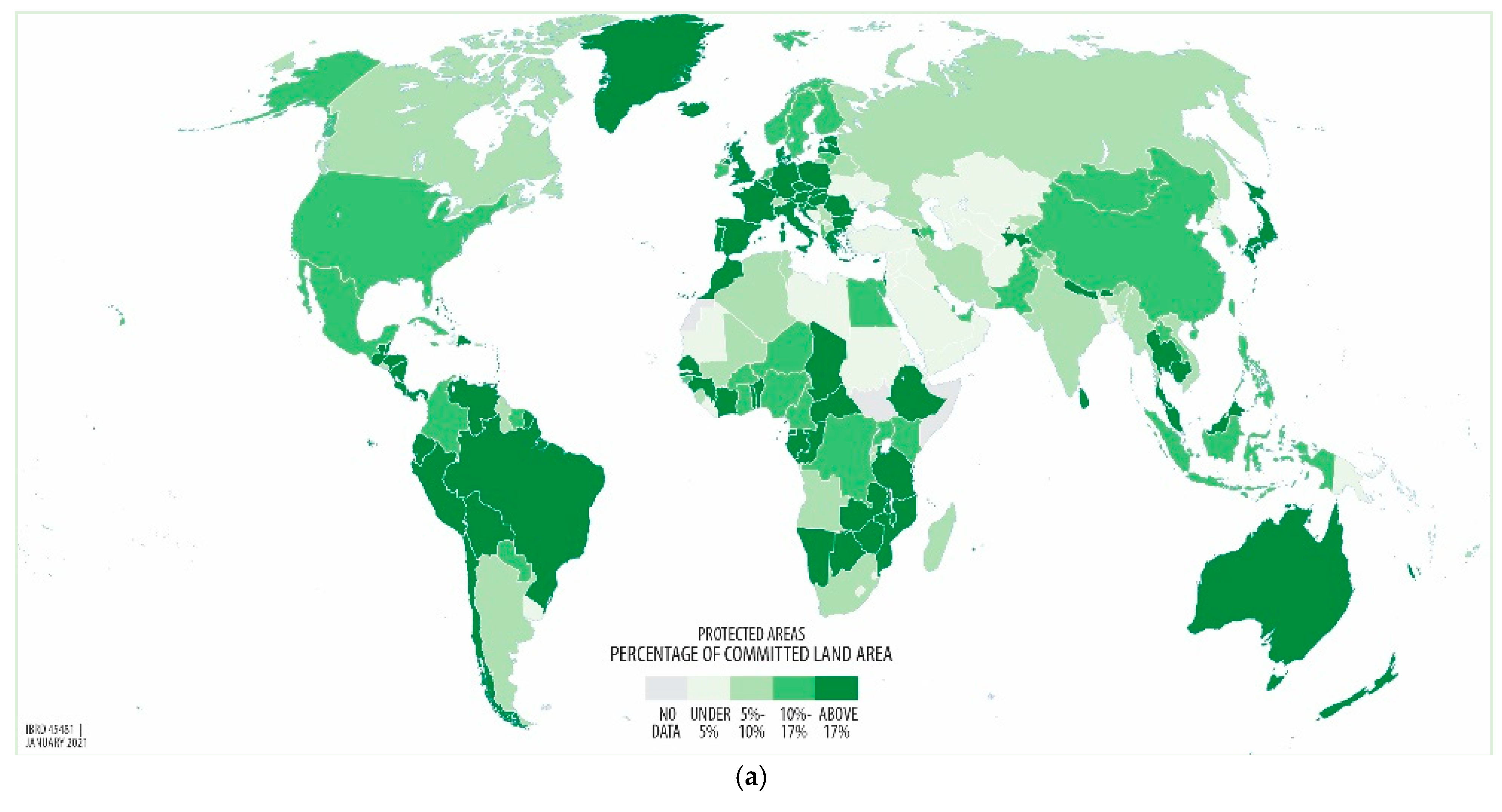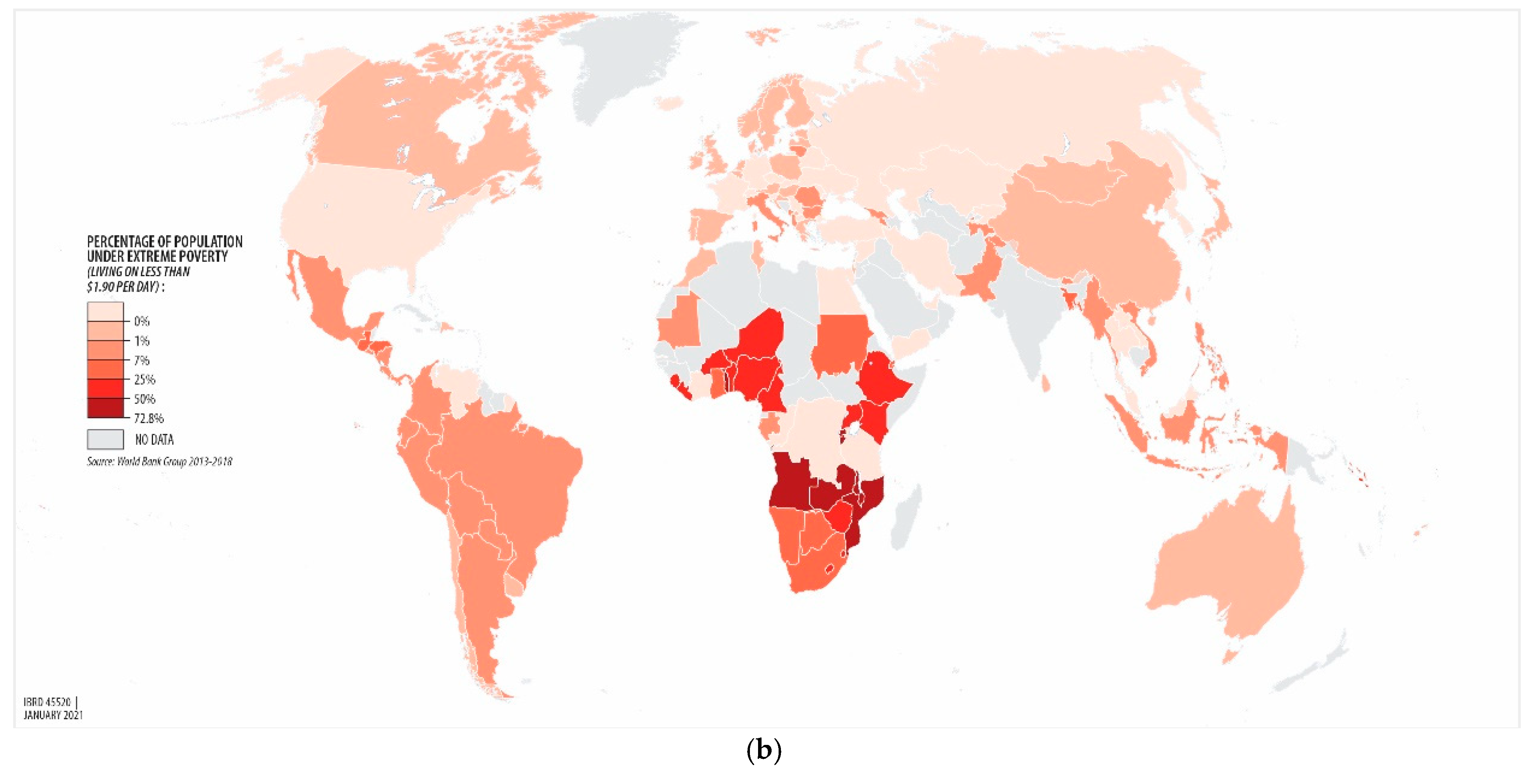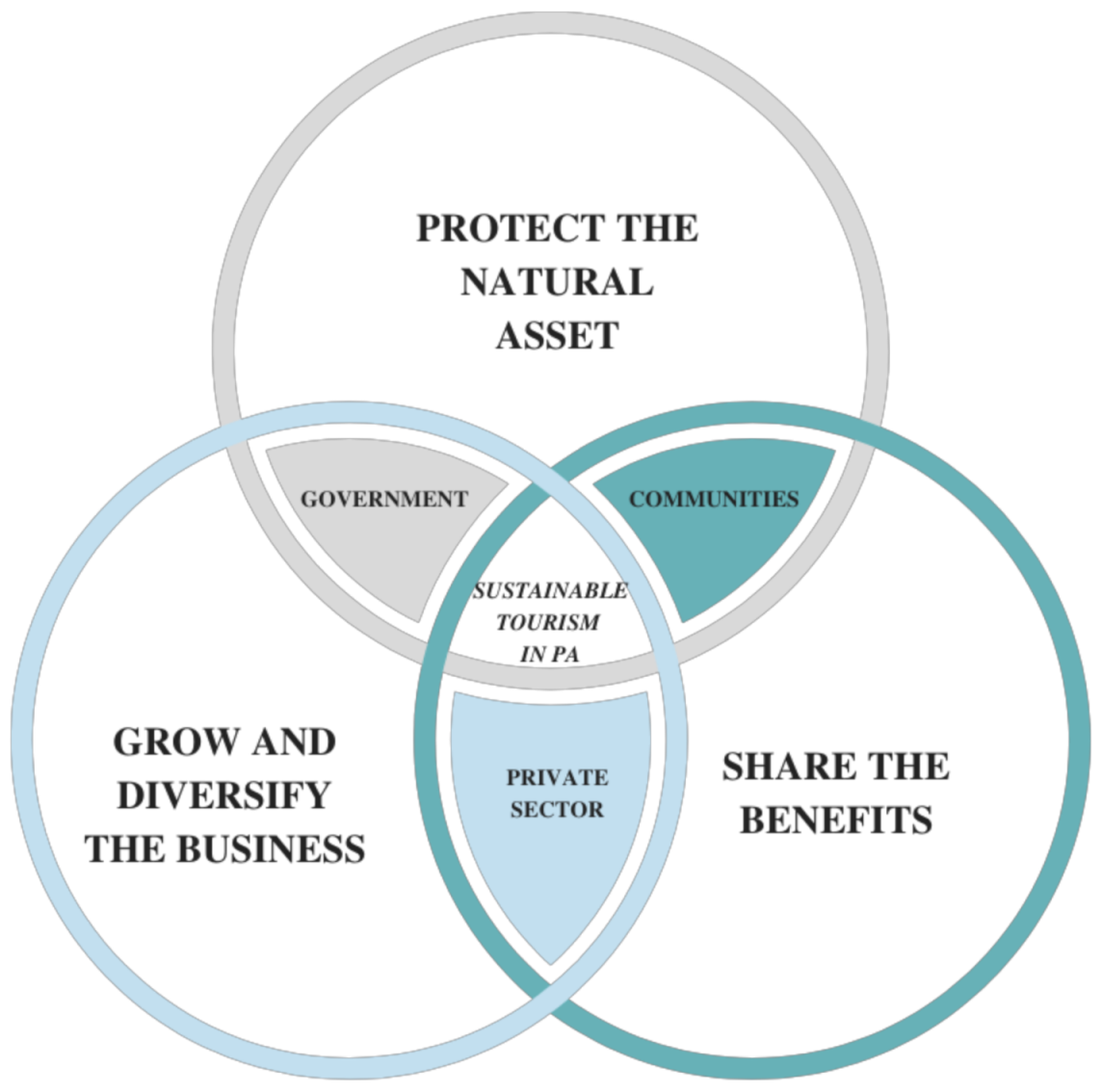Framework for Sustainable Recovery of Tourism in Protected Areas
Abstract
1. Introduction
2. Challenges Preventing Tourism in PAs from Achieving Triple Bottom Line Benefits
2.1. Insufficient Investment and Ineffective Management
2.2. Unsupportive Policy and Regulatory Frameworks for Sustainable Tourism Development
2.3. Limited Benefit-Sharing Arrangements with Communities
3. Sustainable Recovery of Tourism in PA
3.1. Protect the Asset
3.1.1. Increase Public Investment in PA Management
3.1.2. Build Capacity of Protected Area Managers
3.1.3. Undertake Regular Visitor Spending Effects Assessments, at the PA Level and the National Level
3.2. Grow and Diversify the Business
3.2.1. Develop a Strong Concession Policy to Promote Tourism in PAs
- Strong protected area foundational laws and regulations;
- Public support for commercial activity in park areas;
- Demonstrated economic benefit;
- Commercial service/concession laws drafted with input from stakeholders, including potential operators/concessioners, environmental groups, and the general public;
- Provisions in the law that set forth the most important pillars and allow the implementing agency the flexibility to establish the details in policy;
- Socialization of the draft law;
- Implementation of the law through clear and thorough regulations; and
- Evaluation of the implementation of laws and regulations on a continuous basis and modification of regulations when necessary.
3.2.2. Diversify the Tourism Offering across Protected Areas
3.3. Share the Benefits
4. A Green Economic Recovery Initiative: Lessons Learned from the Civilian Conservation Corps
5. Conclusions
Author Contributions
Funding
Institutional Review Board Statement
Informed Consent Statement
Data Availability Statement
Conflicts of Interest
References
- CBD. Biodiversity Year in Review. Convention on Biological Diversity. 2019. Available online: https://www.cbd.int/article/2019-12-20-16-57-49 (accessed on 17 January 2021).
- EBrondizio, S.; Settele, J.; Díaz, S.; Ngo, H. Global Assessment Report on Biodiversity and Ecosystem Services of the Intergovernmental Science-Policy Platform on Biodiversity and Ecosystem Services; IPBES Secretariat: Bonn, Germany, 2019; Available online: https://ipbes.net/global-assessment (accessed on 17 January 2021).
- Watson, J.E.M.; Dudley, N.; Segan, D.B.; Hockings, M. The performance and potential of protected areas. Nature 2014, 515, 67–73. [Google Scholar] [CrossRef]
- Cazalis, V.; Princé, K.; Mihoub, J.-B.; Kelly, J.; Butchart, S.H.M.; Rodrigues, A.S.L. Effectiveness of protected areas in conserving tropical forest birds. Nat. Commun. 2020, 11, 1–8. [Google Scholar] [CrossRef]
- Joppa, L.N.; Bailie, J.E.; Robinson, J.G. Protected Areas: Are They Safeguarding Biodiversity? John Wiley & Sons: Hoboken, NJ, USA, 2016. [Google Scholar]
- UNEP-WCMC; IUCN. Protected Planet: The World Database on Protected Areas (WDPA). Protected Planet Digital Report. 2020. Available online: www.protectedplanet.net (accessed on 6 January 2021).
- Schleicher, J.; Zaehringer, J.G.; Fastré, C.; Vira, B.; Visconti, P.; Sandbrook, C. Protecting half of the planet could directly affect over one billion people. Nat. Sustain. 2019, 2, 1094–1096. [Google Scholar] [CrossRef]
- Dinerstein, E.; Vynne, C.; Sala, E.; Joshi, A.R.; Fernando, S.; Lovejoy, T.E.; Mayorga, J.; Olson, D.; Asner, G.P.; Baillie, J.E.M.; et al. A Global Deal for Nature: Guiding principles, milestones, and targets. Sci. Adv. 2019, 5, eaaw2869. [Google Scholar] [CrossRef]
- Geldmann, J.; Manica, A.; Burgess, N.D.; Coad, L.; Balmford, A. A global-level assessment of the effectiveness of protected areas at resisting anthropogenic pressures. Proc. Natl. Acad. Sci. USA 2019, 116, 23209–23215. [Google Scholar] [CrossRef] [PubMed]
- Jones, K.R.; Venter, O.; Fuller, R.A.; Allan, J.R.; Maxwell, S.L.; Negret, P.J.; Watson, J.E.M. One-third of global protected land is under intense human pressure. Science 2018, 360, 788–791. [Google Scholar] [CrossRef]
- Geldmann, J.; Coad, L.; Barnes, M.D.; Craigie, I.D.; Woodley, S.; Balmford, A.; Brooks, T.M.; Hockings, M.; Knights, K.; Mascia, M.B.; et al. A global analysis of management capacity and ecological outcomes in terrestrial protected areas. Conserv. Lett. 2018, 11, e12434. [Google Scholar] [CrossRef]
- Gill, D.A.; Mascia, M.B.; Ahmadia, G.N.; Glew, L.; Lester, S.E.; Barnes, M.; Craigie, I.; Darling, E.S.; Free, C.M.; Geldmann, J.; et al. Capacity shortfalls hinder the performance of marine protected areas globally. Nature 2017, 543, 665–669. [Google Scholar] [CrossRef] [PubMed]
- Lindsey, P.A.; Miller, J.R.B.; Petracca, L.S.; Coad, L.; Dickman, A.J.; Fitzgerald, K.H.; Flyman, M.V.; Funston, P.J.; Henschel, P.; Kasiki, S.; et al. More than $1 billion needed annually to secure Africa’s protected areas with lions. Proc. Natl. Acad. Sci. USA 2018, 115, E10788–E10796. [Google Scholar] [CrossRef]
- Coad, L.; Watson, J.E.; Geldmann, J.; Burgess, N.D.; Leverington, F.; Hockings, M.; Knights, K.; Di Marco, M. Widespread shortfalls in protected area resourcing undermine efforts to conserve biodiversity. Front. Ecol. Environ. 2019, 17, 259–264. [Google Scholar] [CrossRef]
- Waldron, A.; Miller, D.C.; Redding, D.; Mooers, A.; Kuhn, T.S.; Nibbelink, N.; Roberts, J.T.; Tobias, J.A.; Gittleman, J.L. Reductions in global biodiversity loss predicted from conservation spending. Nature 2017, 551, 364–367. [Google Scholar] [CrossRef]
- Balmford, A.; Gravestock, P.; Hockley, N.; McClean, C.J.; Roberts, C.M. The worldwide costs of marine protected areas. Proc. Natl. Acad. Sci. USA 2004, 101, 9694–9697. [Google Scholar] [CrossRef] [PubMed]
- Balmford, A.; Green, J.M.H.; Anderson, M.; Beresford, J.; Huang, C.; Naidoo, R.; Walpole, M.; Manica, A. Walk on the Wild Side: Estimating the Global Magnitude of Visits to Protected Areas. PLoS Biol. 2015, 13, e1002074. [Google Scholar] [CrossRef]
- Snyman, S.; Bricker, K.S. Living on the edge: Benefit-sharing from protected area tourism. J. Sustain. Tour. 2018, 27, 705–719. [Google Scholar] [CrossRef]
- Snyman, S.L. The role of tourism employment in poverty reduction and community perceptions of conservation and tourism in southern Africa. J. Sustain. Tour. 2012, 20, 395–416. [Google Scholar] [CrossRef]
- WTTC. The Economic Impact of Global Wildlife Tourism. 2019. Available online: https://travesiasdigital.com/wp-content/uploads/2019/08/The-Economic-Impact-of-Global-Wildlife-Tourism-Final-19.pdf (accessed on 9 January 2021).
- IMF. Regional Economic Outlook. Sub-Saharan Africa: A Difficult Road to Recovery; International Monetary Fund: Washington, DC, USA, 2020; ISBN 9781513557601. Available online: https://www.imf.org/-/media/Files/Publications/REO/AFR/2020/October/English/text.ashx (accessed on 13 January 2021).
- Bang, A.; Khadakkar, S. Opinion: Biodiversity conservation during a global crisis: Consequences and the way forward. Proc. Natl. Acad. Sci. USA 2020, 117, 29995–29999. [Google Scholar] [CrossRef] [PubMed]
- Corlett, R.T.; Primack, R.B.; Devictor, V.; Maas, B.; Goswami, V.R.; Bates, A.E.; Koh, L.P.; Regan, T.J.; Loyola, R.; Pakeman, R.J.; et al. Impacts of the coronavirus pandemic on biodiversity conservation. Biol. Conserv. 2020, 246, 108571. [Google Scholar] [CrossRef]
- Di Marco, M.; Baker, M.L.; Daszak, P.; De Barro, P.; Eskew, E.A.; Godde, C.M.; Harwood, T.D.; Herrero, M.; Hoskins, A.J.; Johnson, E.; et al. Opinion: Sustainable development must account for pandemic risk. Proc. Natl. Acad. Sci. USA 2020, 117, 3888–3892. [Google Scholar] [CrossRef] [PubMed]
- Borzée, A.; McNeely, J.; Magellan, K.; Miller, J.R.; Porter, L.; Dutta, T.; Kadinjappalli, K.P.; Sharma, S.; Shahabuddin, G.; Aprilinayati, F.; et al. COVID-19 Highlights the Need for More Effective Wildlife Trade Legislation. Trends Ecol. Evol. 2020, 35, 1052–1055. [Google Scholar] [CrossRef] [PubMed]
- Spenceley, A.; Snyman, S.; Eagles, P. Guidelines for tourism partnerships and concessions for protected areas: Generating sustainable revenues for conservation and development. In Report to the Secretariat of the Convention on Biological Diversity and IUCN; IUCN: Gland, Switzerland, 2017. [Google Scholar]
- Lindsey, P.; Allan, J.; Brehony, P.; Dickman, A.; Robson, A.; Begg, C.; Bhammar, H.; Blanken, L.; Breuer, T.; Fitzgerald, K.; et al. Conserving Africa’s wildlife and wildlands through the COVID-19 crisis and beyond. Nat. Ecol. Evol. 2020, 4, 1300–1310. [Google Scholar] [CrossRef]
- Raven, P.H.; Gereau, R.E.; Phillipson, P.B.; Chatelain, C.; Jenkins, C.N.; Ulloa, C.U. The distribution of biodiversity richness in the tropics. Sci. Adv. 2020, 6, eabc6228. [Google Scholar] [CrossRef]
- Barlow, J.; França, F.; Gardner, T.A.; Hicks, C.C.; Lennox, G.D.; Berenguer, E.; Castello, L.; Economo, E.P.; Ferreira, J.; Guénard, B.; et al. The future of hyperdiverse tropical ecosystems. Nature 2018, 559, 517–526. [Google Scholar] [CrossRef]
- Fisher, B.; Christopher, T. Poverty and biodiversity: Measuring the overlap of human poverty and the biodiversity hotspots. Ecol. Econ. 2007, 62, 93–101. [Google Scholar] [CrossRef]
- Naidoo, R.; Gerkey, D.; Hole, D.; Pfaff, A.; Ellis, A.M.; Golden, C.D.; Herrera, D.; Johnson, K.; Mulligan, M.; Ricketts, T.H.; et al. Evaluating the impacts of protected areas on human well-being across the developing world. Sci. Adv. 2019, 5, eaav3006. [Google Scholar] [CrossRef] [PubMed]
- World Bank. Poverty | Data. 2018. Available online: https://data.worldbank.org/topic/11 (accessed on 26 January 2021).
- IUCN ESARO. Closing the gap. The Financing and Resourcing of Protected and Conserved Areas in Eastern and Southern Africa; IUCN ESARO; BIOPAMA: Nairobi, Kenya, 2020; Available online: https://portals.iucn.org/library/node/49045 (accessed on 25 January 2021).
- Hockings, M.; Stolton, S.; Leverington, F.; Dudley, N.; Courrau, J. Evaluating Effectiveness: A Framework for Assessing Management Effectiveness of Protected Areas, 2nd ed.; IUCN: Gland, Switzerland; Cambridge, UK, 2006; Available online: https://portals.iucn.org/library/sites/library/files/documents/PAG-014.pdf (accessed on 29 January 2021).
- Bovarnick, A.; Fernandez, B.J.; Galindo, J.; Negret, H. Financial Sustainability of Protected Areas in Latin America and the Caribbean: Investment Policy Guidance. United Nations Development Programme (UNDP) and The Nature Conservancy (TNC). 2010. Available online: https://www.undp.org/content/undp/en/home/librarypage/environment-energy/ecosystems_and_biodiversity/financial-sustainability-of-protected-areas-in-latin-america-and-the-caribbean.html (accessed on 25 January 2021).
- Leverington, F.; Costa, K.L.; Courrau, J.; Pavese, H.; Nolte, C.; Marr, M.; Coad, L.; Burgess, N.; Bomhard, B.; Hockings, M. Management Effectiveness Evaluation in Protected Areas–A Global Study; The University of Queensland: Brisbane, Australia, 2010; Available online: https://www.unep-wcmc.org/system/dataset_file_fields/files/000/000/102/original/Leverington_et_al._2010.pdf?1398678168 (accessed on 25 January 2021).
- Leung, Y.F.; Spenceley, A.; Hvenegaard, G.; Buckley, R. (Eds.) Tourism and Visitor Management in Protected Areas: Guidelines for Sustainability; IUCN: Gland, Switzerland, 2018. Available online: https://www.sprep.org/attachments/VirLib/Global/tourism-protected-areas.pdf (accessed on 9 January 2021).
- Mbaiwa, J.E. The socio-economic and environmental impacts of tourism development on the Okavango Delta, north-western Botswana. J. Arid Environ. 2003, 54, 447–467. [Google Scholar] [CrossRef]
- Schulze, K.; Knights, K.; Coad, L.; Geldmann, J.; Leverington, F.; Eassom, A.; Marr, M.; Butchart, S.H.M.; Hockings, M.; Burgess, N.D. An assessment of threats to terrestrial protected areas. Conserv. Lett. 2018, 11, e12435. [Google Scholar] [CrossRef]
- Newsome, D.; Hughes, M. The contemporary conservation reserve visitor phenomenon! Biodivers. Conserv. 2018, 27, 521–529. [Google Scholar] [CrossRef]
- Thompson, A.; Massyn, P.J.; Pendry, J. Tourism Concessions in Protected Natural Areas: Guidelines for Managers; United Nations Development Programme: New York, NY, USA, 2014. [Google Scholar]
- Wyman, M.; Barborak, J.R.; Inamdar, N.; Stein, T. Best Practices for Tourism Concessions in Protected Areas: A Review of the Field. Forests 2011, 2, 913–928. [Google Scholar] [CrossRef]
- Sandbrook, C.G. Putting leakage in its place: The significance of retained tourism revenue in the local context in Rural Uganda. J. Int. Dev. 2008, 22, 124–136. [Google Scholar] [CrossRef]
- Rylance, A.; Spenceley, A. Reducing economic leakages from tourism: A value chain assessment of the tourism industry in Kasane, Botswana. Dev. South. Afr. 2017, 34, 295–313. [Google Scholar] [CrossRef]
- Spenceley, A.; Snyman, S.; Rylance, A. Revenue sharing from tourism in terrestrial African protected areas. J. Sustain. Tour. 2017, 27, 720–734. [Google Scholar] [CrossRef]
- McCarthy, D.P.; Donald, P.F.; Scharlemann, J.P.W.; Buchanan, G.M.; Balmford, A.; Green, J.M.H.; Bennun, L.A.; Burgess, N.D.; Fishpool, L.D.C.; Garnett, S.T.; et al. Financial Costs of Meeting Global Biodiversity Conservation Targets: Current Spending and Unmet Needs. Science 2012, 338, 946–949. [Google Scholar] [CrossRef]
- Waldron, A.; Mooers, A.O.; Miller, D.C.; Nibbelink, N.; Redding, D.; Kuhn, T.S.; Roberts, J.T.; Gittleman, J.L. Targeting global conservation funding to limit immediate biodiversity declines. Proc. Natl. Acad. Sci. USA 2013, 110, 12144–12148. [Google Scholar] [CrossRef] [PubMed]
- Baghai, M.; Miller, J.R.; Blanken, L.J.; Dublin, H.T.; Fitzgerald, K.H.; Gandiwa, P.; Laurenson, K.; Milanzi, J.; Nelson, A.; Lindsey, P. Models for the collaborative management of Africa’s protected areas. Biol. Conserv. 2018, 218, 73–82. [Google Scholar] [CrossRef]
- Doinjashvili, P.; Méral, P.; Andriamahefazafy, F. Sustaining protected areas through conservation trust funds: A review. Int. J. Sustain. Dev. World Ecol. 2020, 1–10. [Google Scholar] [CrossRef]
- Withers, O.; Zoltani, T. Chapter 37—Leveraging support for pangolin conservation and the potential of innovative finance. In Pangolins; Challender, D.W.S., Nash, H.C., Waterman, C., Eds.; Academic Press: Cambridge, MA, USA, 2020; pp. 579–595. [Google Scholar]
- Börner, J.; Baylis, K.; Corbera, E.; Ezzine-De-Blas, D.; Honey-Rosés, J.; Persson, U.M.; Wunder, S. The Effectiveness of Payments for Environmental Services. World Dev. 2017, 96, 359–374. [Google Scholar] [CrossRef]
- Oldekop, J.A.; Holmes, G.; Harris, W.E.; Evans, K.L. A global assessment of the social and conservation outcomes of protected areas. Conserv. Biol. 2016, 30, 133–141. [Google Scholar] [CrossRef]
- Paige, J.C. The Civilian Conservation Corps and The National Park Service, 1933–1942: An Administrative History; National Park Service, Department of the Interior: Fort Collins, CO, USA, 1985.
- Thomas, C.C.; Koontz, L. 2019 National Park Visitor Spending Effects: Economic Contributions to Local Communities, States, and the Nation; Natural Resource Report; National Park Service: Fort Collins, CO, USA, 2020; NPS/NRSS/EQD/NRR–2020/2110. Available online: https://www.nps.gov/subjects/socialscience/vse.htm (accessed on 25 January 2021).
- FACT SHEET: President Biden Takes Executive Actions to Tackle the Climate Crisis at Home and Abroad, Create Jobs, and Restore Scientific Integrity across Federal Government. The White House. 27 January 2021. Available online: https://www.whitehouse.gov/briefing-room/statements-releases/2021/01/27/fact-sheet-president-biden-takes-executive-actions-to-tackle-the-climate-crisis-at-home-and-abroad-create-jobs-and-restore-scientific-integrity-across-federal-government/ (accessed on 29 January 2021).
- Khan, M.A.A. Opinion: Pakistan’s ‘Green Stimulus’ to Combat Covid-19, Protect Nature. The Third Pole. Available online: https://www.thethirdpole.net/2020/05/04/pakistans-green-stimulus-to-combat-covid-19-protect-nature/ (accessed on 25 January 2021).
- Pakistan’s ‘Protected Areas Initiative. The Express Tribune. 10 July 2020. Available online: http://tribune.com.pk/story/2254293/pakistans-protected-areas-initiative (accessed on 29 January 2021).



| Tourism Impact | Avenues/Opportunities to Increase Benefits |
|---|---|
| Direct | Formalizing revenue-sharing mechanisms Building capacity and developing skills Promoting sustainable use of natural resources Reducing human–wildlife conflict through mitigation or compensation Implementing inclusive governance models |
| Indirect | Hiring of local labor for tourism and PA management Encouraging local sourcing of goods by tourism establishments Strengthening market linkages Offering small grants for business and enterprises Providing extension and support services to boost agricultural productivity and increase capacity of local communities to supply goods and services |
Publisher’s Note: MDPI stays neutral with regard to jurisdictional claims in published maps and institutional affiliations. |
© 2021 by the authors. Licensee MDPI, Basel, Switzerland. This article is an open access article distributed under the terms and conditions of the Creative Commons Attribution (CC BY) license (http://creativecommons.org/licenses/by/4.0/).
Share and Cite
Bhammar, H.; Li, W.; Molina, C.M.M.; Hickey, V.; Pendry, J.; Narain, U. Framework for Sustainable Recovery of Tourism in Protected Areas. Sustainability 2021, 13, 2798. https://doi.org/10.3390/su13052798
Bhammar H, Li W, Molina CMM, Hickey V, Pendry J, Narain U. Framework for Sustainable Recovery of Tourism in Protected Areas. Sustainability. 2021; 13(5):2798. https://doi.org/10.3390/su13052798
Chicago/Turabian StyleBhammar, Hasita, Wendy Li, Christel Maria Moller Molina, Valerie Hickey, Jo Pendry, and Urvashi Narain. 2021. "Framework for Sustainable Recovery of Tourism in Protected Areas" Sustainability 13, no. 5: 2798. https://doi.org/10.3390/su13052798
APA StyleBhammar, H., Li, W., Molina, C. M. M., Hickey, V., Pendry, J., & Narain, U. (2021). Framework for Sustainable Recovery of Tourism in Protected Areas. Sustainability, 13(5), 2798. https://doi.org/10.3390/su13052798





